What Types of Maintenance Should be Done on a Water Heater?
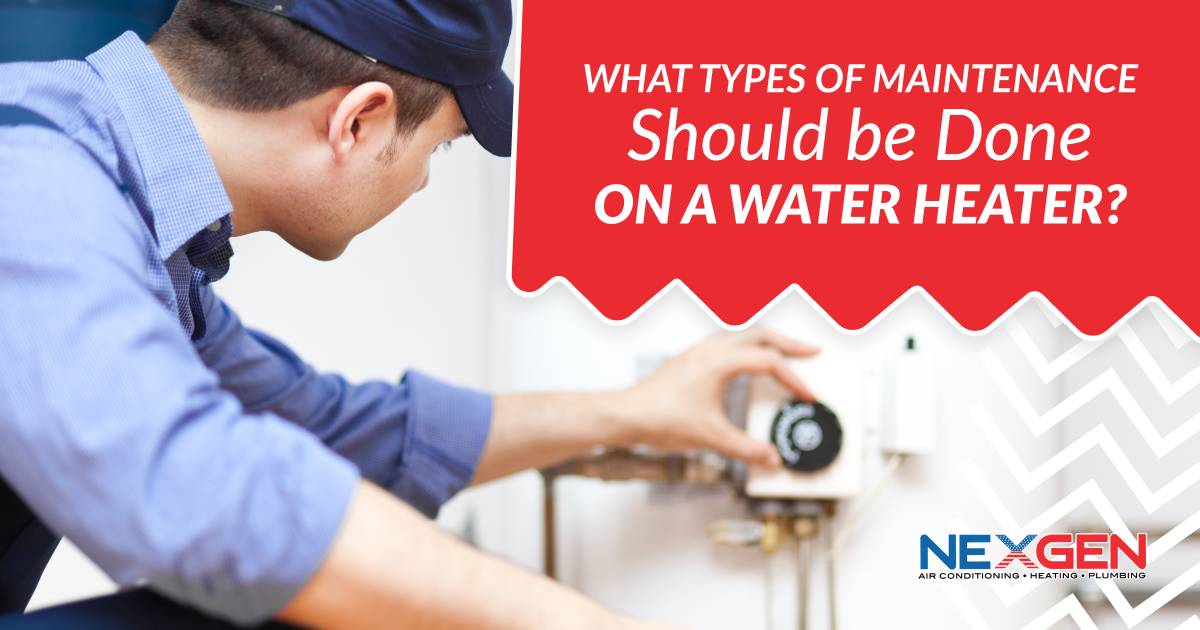
Water heater maintenance consists of various tasks, some of which you may be tempted to try yourself. It’s best to schedule maintenance service every year. A plumbing services professional has the tools and equipment to inspect and test the unit to make sure it’s working properly. The following steps enable a contractor to help your water heater run smoothly, reliably, and efficiently.
Flush the Tank
Your water heater should be flushed at least once a year. The process entails draining the unit. First, the technician turns the system off. If it’s gas-powered, the gas supply valve is shut. Next, a hose is attached to the drain valve and the valve is opened.
The water may be dark or cloudy at first, but the tech will let it run and drain until it is clear (they’ll open and close the cold-water supply valve to stir up the sediment and improve drainage); this should take 20 to 25 minutes. Lastly, the drain is closed, the tank is refilled, and the power is restored.
Check the Anode Rod
The sacrificial anode rod attracts corrosive elements, so they don’t damage the tank. Over time, the metal rod will corrode; it should be replaced every three to five years. To check the anode rod, a technician partially drains the tank and unscrews it using a 1 1/16-inch socket on the hex head at the top of the water heater.
The rod is replaced if it’s less than ½ inch thick or completely coated. It can be difficult to remove, so it’s best for a technician to check it and, if necessary, install a new anode rod.
Adjust the Temperature
A maintenance contractor sometimes adjusts the water temperature using the water heater’s thermostat. If it’s set to 140℉, that’s too high; you risk getting burned and the water heater will use more energy than necessary. Setting the unit to as low as 120℉ prevents scalding and bacterial growth.
The thermostat for a gas water heater is located on the tank. An electric water heater must be powered down by flipping the circuit breaker on the main panel. Pulling back insulation exposes the thermostat, which can be adjusted (in 10-degree increments) using a flathead screwdriver. You can lower the unit’s energy consumption by 5% for every 10 degrees you lower the water temperature.
Test the Temperature Pressure Relief (TPR) Valve
Tank-based water heaters have a safety feature that releases pressure if the water gets too hot. Since water expands when it heats, it can put immense pressure on the tank until it bursts. A maintenance tech will test the TPR valve each year. However, you can test it by lifting the valve’s lever and letting out some water. Have the valve replaced if no water comes out or flows out in large amounts (the water should start flowing and then stop). We recommend testing the TPR valve monthly.
Insulate the Water Heater and Pipes
A water heater can be covered with an insulating blanket, such as a foil-covered bubble wrap. When wrapping the tank, avoid covering the top if you have a gas or oil water heater, and fit it around the pipes, TPR valve, and temperature control. For an electric water heater, tape the edge of the insulating material to the side of the tank. Insulating the pipes going to and from the unit helps keep water hot as it moves toward fixtures and can prevent frozen pipes in winter.
Replace the Air Intake Filter
Tankless water heaters have an air intake. A filter prevents dust and debris from getting in and causing damage. If it is dirty or clogged, the unit can overheat and shut down. Therefore, replacing the air intake filter can avoid costly repairs or having to replace the water heater prematurely.
More Tips for Water Heater Maintenance
In addition to the types of maintenance described above, these tips can help your water heater run more smoothly and efficiently:
- If you have hard water, flush your water heater every six months or more often.
- Lower the thermostat temperature or use the vacation setting if you leave town for more than a few days.
- If there’s a leak, check for and tighten a loose drain valve.
- Periodically check for leaks, a hot tank, strange noises, or signs of damage.
- Keep combustible materials away from the water heater.
- For gas water heaters, check that the vent pipe is clear and the vent connector is properly sealed.
Schedule Water Heater Maintenance with NexGen
Flushing the tank and water lines, insulating the system, and testing the TPR valve can help improve the performance, efficiency, and longevity of a water heater. At NexGen, our licensed and insured technicians are familiar with every aspect of water heater maintenance and are equipped to deal with and resolve any issue. They can help you save in the long run. Our X Protection Plan includes one water heater flush per year plus discounts on repairs and other benefits. To learn more and schedule water heater maintenance and other plumbing services in Southern California, call (805) 301-6788.
The Tankless Water Heater Installation Process
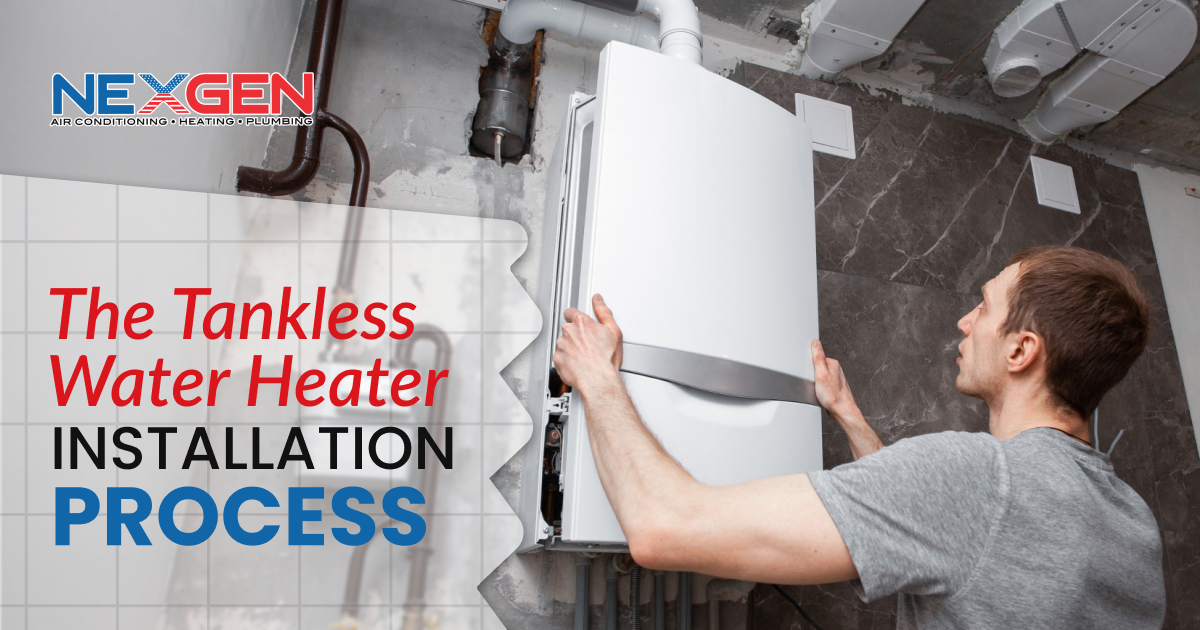
It’s best to leave tankless water heater installation to a professional. The process is too complex for a DIYer. While tankless units are smaller and more straightforward than traditional tank-based water heaters, they require precise connections. Any mistakes can reduce efficiency and put your safety at risk.
NexGen specializes in water heater repair and installation. If you’ve never had a tankless water heater installed, here’s a look at how the installation process works:
Preparation
Plumbing, gas, electrical, and vent work may be required before disconnecting your old water heater. Assuming you’re installing a gas unit, the gas meter may be upgraded, especially if your existing one doesn’t have enough capacity to supply the tankless water heater and all your other gas appliances. A tank water heater may use 30K British Thermal Units (BTUs) per hour while a tankless system may require 90K to 130K BTU/H.
Your local gas company can check the meter to determine if any updates are needed.
You’ll also need a professional to run a 1-inch gas pipe from the meter to the water heater, along with another gas shutoff valve. A stainless steel exhaust pipe is installed. It includes a fan that pushes out air and condensation. High-efficiency units can be served by a plastic pipe. If you live in a colder climate, installing a damper protects the system from cold air.
Electrical work may be necessary as well. Gas units use 120 V electrical power and need a dedicated outlet or junction box. However, an electric water heater requires a 240 V circuit along with a subpanel (plus wiring between the two).
Remove the Old Water Heater
Before removing the water heater, the water supply and gas lines are turned off. The water is also drained from the tank. A heat-rated hose is used to drain the system (a typical garden hose will be damaged). Opening a hot water faucet releases pressure. Once the tank is drained, the water and gas lines are disconnected, which typically requires a pipe wrench or channel-type pliers. The unit is then disposed of per local codes and regulations.
Set Up the Pipes
A location is chosen for tankless water heater installation. The technician drills a hole in an outside wall close to the water heater. Through here, PVC pipes for the fresh air intake and vent are inserted. A traditional chimney won’t be effective because the flue gas temperatures on a tankless system are too low. Instead, the system can be vented through a rim joist.
The contractor taps into an existing tee if your gas line is the proper size and the unit is being installed where your old water heater was. A gas shutoff valve, tee, and sediment trap are installed. A flexible line is run from the tee to where it can be attached to the unit.
Copper pipe is used for connecting new hot and cold water lines to existing plumbing. The new lines are run to the new water heater and cut and soldered as needed. The copper lines may also need to be deburred and sweated; the plumber will secure the pipe to the wall with bell hangers. An expansion tank may be installed near the cold intake.
Mount the Tankless Water Heater
When installing a tankless unit, the contractor can set it flush against the drywall or plaster. It can also be set into the wall between studs. The unit is mounted according to the manufacturer’s instructions. Water supply and outlet pipes are routed and connected to it and shutoff valves are installed on both lines nearby. Inlet and outlet connections are finalized with union fittings.
To set up the water heater, water valves, and faucets are opened. The electricity and gas are not yet turned on. Water is allowed to run through the unit for a minute or so and then turned off (to purge air from the water pipes and heater). The inline filter is removed, debris is cleaned out, and then the filter is replaced, water valves are opened, and power and gas are restored. The technician then tests the unit to ensure proper operation.
Install System Valves
During installation, a pressure relief valve is installed. It’s a safety device that opens if system pressure is too high (often due to overheated water). A purge valve is also installed to simplify maintenance. In addition, the plumber can install a crossover valve at the furthest plumbing fixture, which allows a recirculation pump to deliver hot water.
Why Do I Need a Plumber for Tankless Water Heater Installation
Whether you’re upgrading from a traditional unit or replacing a tankless water heater with a new one, extensive water and gas line work is required. There are many safety hazards associated with installing gas and electric water heaters. A licensed plumber knows how to address these and meet permit requirements, comply with code regulations, and satisfy the terms of the warranty.
Most importantly, they can avoid damage to the equipment and your home. There are also rules for the removal and disposal of old water heaters, which a professional plumber is familiar with. They ensure your old system is taken away safely without violating any regulations.
Contact NexGen
NexGen is trusted for tankless water heater installation and replacement throughout Southern California. Our technicians are fully licensed and insured. They’ll help determine the best model to install, provide a free estimate, and discuss your financing options. We also offer competitive pricing and a price match guarantee, which can help manage installation/replacement costs (these can be offset by increased efficiency and lower maintenance requirements). For more information, call (805) 301-6788 today.
Can Water Heater Repair Improve Efficiency?
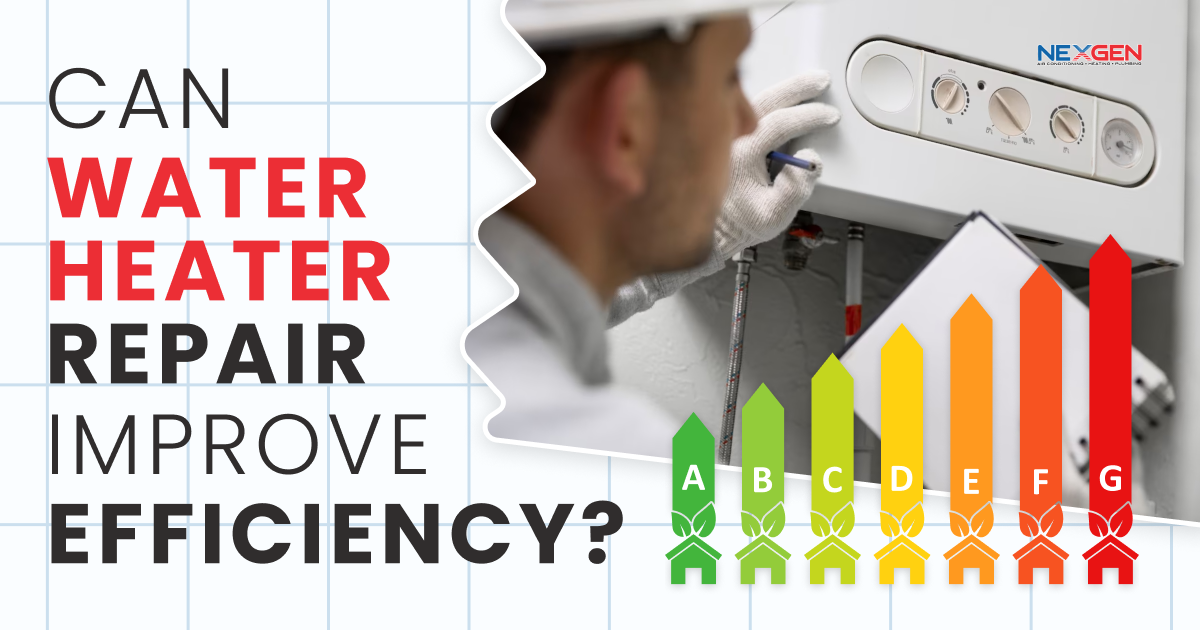
Improved efficiency is one of the greatest benefits of water heater repair. A technician can correct issues that cause the unit to be overworked and consume more energy. We’ll explain in more detail how repairing your water heater enables it to run more efficiently.
If your water heater needs to be repaired, its efficiency can be reduced due to these factors:
- The System Uses More Electricity: If a burner or heating element is malfunctioning or there’s a problem with an electrical connection, the unit may draw more power. Therefore, it becomes less energy efficient.
- An Increase in Water Usage: A struggling water heater will take longer to produce hot water. Therefore, you’ll leave a water faucet or fixture running longer, so water is wasted as you wait for it to become hot. Water heater repair can improve efficiency simply by reducing water consumption.
- A Heating Element Fails: An electric water heater usually has two heating elements. The second element will work twice as hard if the first breaks, causing the water heater to work less efficiently.
- Sediment in the Tank: A water heater in disrepair may have sediment in the tank. It typically originates from minerals in the water that crystalize and settle to the bottom. A buildup of sediment slows down the system and forces it to use more energy.
Water Heater Repairs Help Improve Energy Efficiency
A problem with a gas control, burner, or temperature-pressure relief valve can interfere with the unit’s water-heating ability. To restore performance, the technician can check for, find, and fix these issues. Replacing a small component is often enough. But a lack of hot water can also be due to a faulty thermostat. Call for help if adjusting the thermostat doesn’t increase or decrease water temperature.
However, if the tank is leaking, the water heater will have to be replaced. A leaky tank can significantly reduce efficiency. The system will also struggle to maintain the proper water temperature. Leaking water can increase your water bill and cause water damage as well.
Other Ways to Improve Water Heater Efficiency
Water heater repair comes in many forms, and maintenance is also important. You don’t have to wait for the water heater to break down for a technician to help it run more efficiently. Here are a few ways they can reduce energy consumption:
- Flush the Water Heater: You can follow the manufacturer’s instructions for draining sediment from the tank. Or, you can hire a technician who can quickly flush the tank to ensure the system runs at peak efficiency.
- Insulate the Tank and Pipes: Heat energy can escape through the tank and the piping connected to your water heater. By insulating the water storage tank and exposed piping, heat loss can be minimized. An insulation blanket is an easy and inexpensive way to protect the tank.
- Install a Volt Timer: A tank water heater works 24/7 to keep water hot. If you have an electric unit, a contractor can install a volt timer that turns it off at night when you are asleep. That’s one-third of the day the unit isn’t consuming energy.
Call NexGen for Water Heater Repair
Whether you need help with water heater repair or installation, you can trust NexGen for high-quality service. Our licensed, experienced technicians ensure water heaters in homes and businesses across Southern California work flawlessly. They can diagnose and fix any problem to improve your system’s performance and efficiency. To request help, book service online or call (833) 729-9735.
Tankless Water Heater vs. Traditional Water Heater

Choosing a water heater can be a big decision for a homeowner or contractor, many factors go into selecting the correct water heater for any home. A few of these factors can include Cost, Efficiency, and Longevity. If you are selecting a water heater for the first time or replacing an old one this decision can be tolling, and that is why we are here today to discuss the differences between the two types, Tankless vs a Traditional. We will also examine the pros and cons of both types so you can leave here feeling informed and confident in your decision.
Traditional Tank Storage Water Heaters
Tank Water Heaters are the most common type of water heater and can be found in most homes around the United States. They typically hold around 30 to 50 gallons of water and stores water until needed. The tank feeds a pipe which then feeds the rest of the home. The heater uses natural gas or electricity to fuel the system. Gas tends to be more expensive than electric.
Tankless Water Heaters
Tankless Water Heaters as known to be on demand type heaters because they use burners to rapidly heat the water running through the heat exchanger. After the water is heated it is delivered straight to your pipes which then feed your faucets and showers without any need for a storage tank.
Pros and Cons
Tankless Water Heaters: these types of heaters tend to be a little more expensive than traditional buy ativan without prescription storage tank heaters because of their upfront costs to install in the home. But do not let this scare you away, these upfront costs are offset by the great efficiency that comes with the product. These systems tend to be 25 to 35 percent more energy efficient than traditional tank heaters. The longevity of these heaters is also a big plus! They usually last around 20 to 30 years but come with the scare of high replacement costs. The tankless water heater is a bit more costly to buy and install so be aware if you are on a budget.
Storage Tank Water Heaters: the tank heaters are a much more traditional option for anyone looking to make a safe decision. These systems tend to be much cheaper to install and maintain because of the simplicity of the heaters. There are a few negatives to the tank water heater, one is the looming scare of a flood occurring. These tanks tend to leak or burst over the years as they get older which could cause huge issues to the structure of the home. Another negative is the fact that the utility bill tends to be higher for these water heaters. If you are a huge hot water consumer, you might want to consider a tankless water heater because of their efficiency.
Call NexGen HVAC & Plumbing
Our expertise and commitment to customer satisfaction make us the leading HVAC company in Southern California. To learn more about our equipment, services, and protection plan, book an appointment online or call 888-277-0415.
Types of Tankless Water Heaters
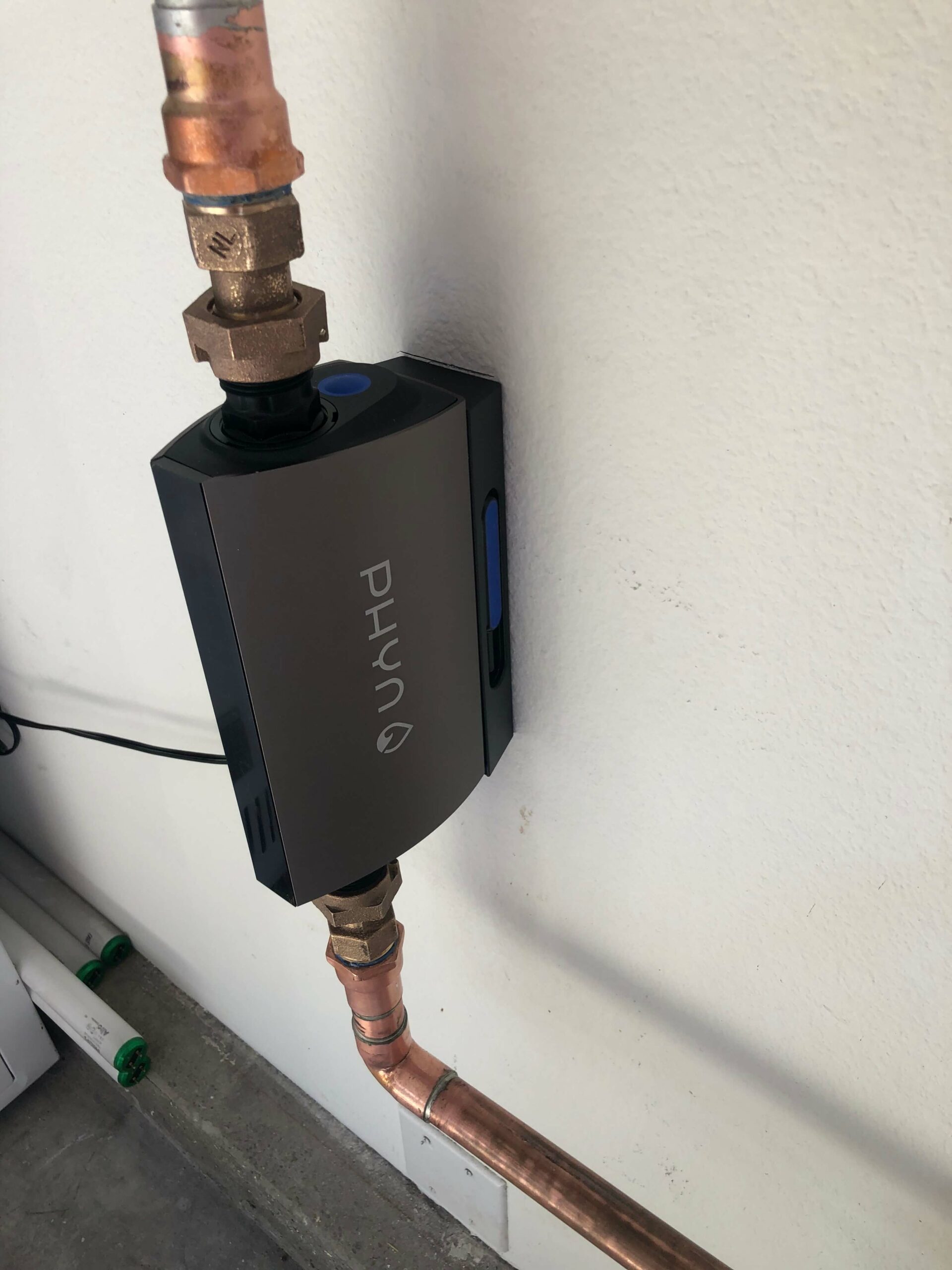
Tankless water heaters have become very popular lately for several good reasons. Tankless hot water heaters are more energy efficient than traditional units because they heat water as it is used, rather than heating and reheating water in a storage tank. They also take up significantly less physical space, as they do not have a bulky storage tank. But what kind is going to be right for your home and what should you know about them?
There are three types of tankless hot water heaters available:
Non-condensing:
This is the first generation of tankless unit. These units use a heat exchanger to heat your water on-demand, and reach an Efficiency Factor (EF) of .82-.85. This technology has been in use in Europe and Japan for decades and is well-proven. The advantage of this type of unit is in reliability in that they are established products with few manufacturing issues. Some of the drawbacks of non-condensing units include hot exhaust, which means you have to install (expensive) stainless steel venting, and lower energy efficiency – in particular, the efficiency of these units drop when you use lots of hot water in short draws (i.e. washing your hands).
Condensing:
Condensing units are the second generation of tankless water heaters. After a primary heat exchanger, these units use a second heat exchanger, which reuses the heat from your exhaust to further heat the water. This results in an increased efficiency of 92-94%. The benefit of cooler exhaust is that these units can be vented using (inexpensive) PVC, while the drawbacks included a higher unit cost and, similar to non-condensing units, a lower efficiency for short water draws.
Condensing hybrid:
Condensing hybrid units are the third generation of tankless water heaters and were pioneered in the United States. These heaters incorporate a small – between 1 liter and 2-gallon – holding tank. This small holding tank keeps a reservoir of hot water, eliminating lower efficiency for short draws, meaning these water heaters achieve a true EF of .92-.96. A recent study by the Gas Technology Institute measured real life efficiency of condensing hybrid tankless water heaters and found the units consistently operated at 94% efficiency with little to no degradation due to short draws.
These units can also be vented in PVC which is less expensive. In some cases, the units also addressed “cold water sandwich” issues and pressure fluctuations that sometimes occurred with first and second-generation models. There may also be slightly less lag in the time it takes to deliver hot water to the tap or appliance. One of the drawbacks (as of writing) of this technology is that because it’s newer, most models are manufactured by smaller companies. In some cases, there have been manufacturing-quality and warranty issues with these units. Product reliability is improving but it’s important to be careful about the brand you purchase.
Call NexGen HVAC & Plumbing
Our expertise and commitment to customer satisfaction make us the leading HVAC company in Southern California. To learn more about our equipment, services, and protection plan, book an appointment online or call 888-277-0415.
Why Go Tankless? The Benefits of Upgrading from Your Tank-Type Water Heater
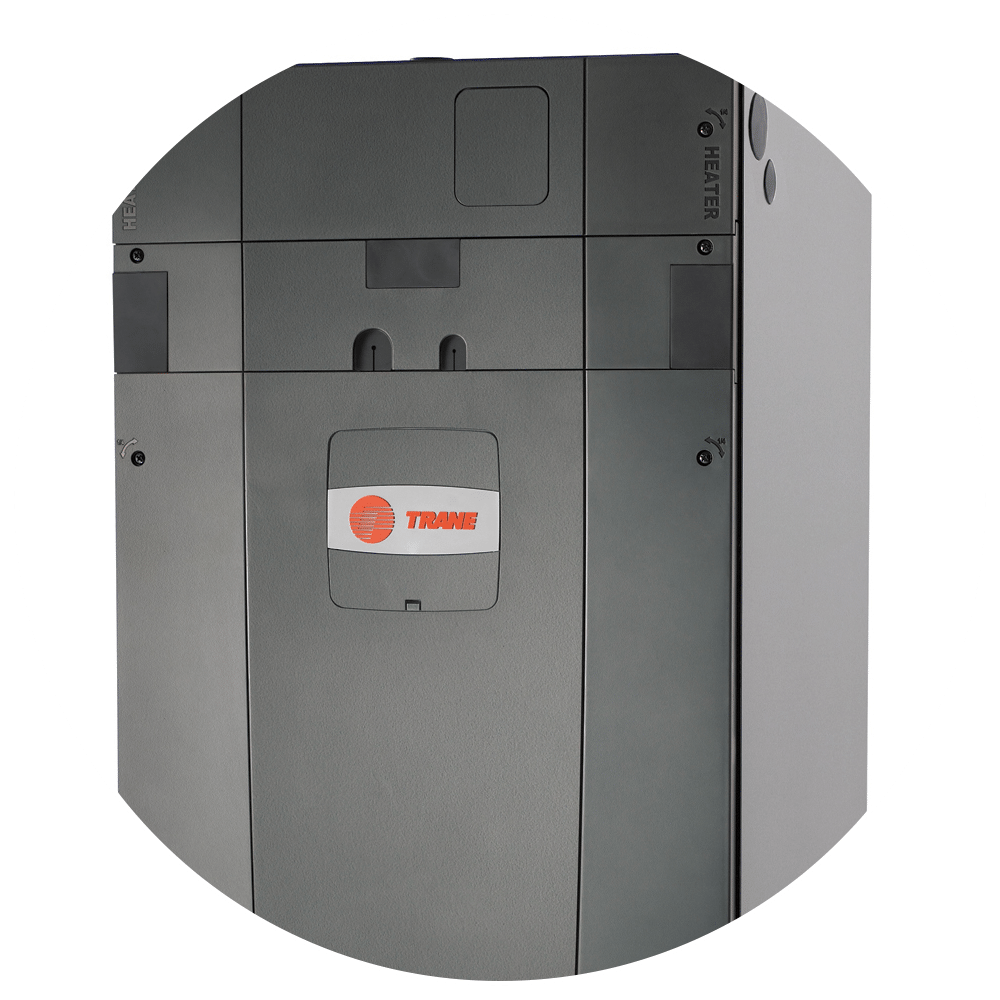
Hot water on demand is one of the best perks a home can provide, right along with air conditioning and the garbage disposal. However, like any other major home appliance, water heaters eventually break down, especially storage tank water heaters. If your storage tank water heater has seen better days, it could be time to consider upgrading to a tankless water heater.
The Perks of a Tankless Water Heater
Whether or not you need to replace your water heater, the benefits of installing a tankless water heater are worth the cost and effort. Storage tank water heaters need to run constantly to keep the water inside the tank hot. Generally storing 30-50 gallons of hot water, there’s a limited hot water supply. What’s also important to note is that the operating costs of a tank storage water heater are expensive because it’s always running to keep the water heated. In comparison to the 20-30 lifespan of a tankless water heater, the average lifespan of a storage tank water heater is 10-15 years. The benefits of a tankless water heater include much more than efficiency, and here’s why.
No flood risk
A tankless water heater doesn’t have a tank that can crack or rupture. When a storage tank water heater has reached the end of its warranty, it might mean 30-50 gallons of water flooding your basement. This occurs when there’s enough of a buildup of mineral deposits inside the water heater’s tank, creating pressure until it bursts and resulting in some devastating water damage.
It doesn’t take up much space
One great perk, especially if you have plans to renovate the basement, is that a tankless water heater takes very little space. Without the 30-50 gallon tank, you can mount a tankless water heater just about anywhere.
They’re energy efficient.
Since there is no tank, which means there is no standby heat loss, a tankless water heater literally provides hot water on demand. A storage tank water heater needs to constantly heat the water inside the tank, regardless if you’re using the hot water or not. A tankless water heater can provide up to 5 gallons of hot water a minute, but no hot water is wasted.
You save money
Because they’re energy efficient, tankless water heaters use 30-50 % less energy than storage tank water heaters, resulting in homeowners saving up to $100 and more a year. Most tankless water heaters also come with a tax rebate.
It’s better for the environment
For the eco-conscious homeowner, tankless water heaters not only benefit the environment by being energy efficient. In fact, most tankless water heaters are built from recyclable materials, which mean one less major appliance ending up in the landfill.
What to Consider When Installing a Tankless Water Heater
If you’re ready to invest in a tankless water heater, it’s important to first consider the different types of tankless water heaters and what works best for you. Size, fuel type, and efficiency are a few important factors to think about when selecting a tankless water heater. Before contacting a plumber, consider the following.
Fuel type
There are three fuel types for a tankless water heater: gas, propane, and electric. Picking a fuel type usually depends on what type of fuel is available in your area and switching fuel types can be costly. Gas is much faster and efficient at heating water, but requires a high heat output. Electric tends to be cheaper to install, but demands a great deal of electricity to operate.
Gallons per minute (GPM)
Since a tankless water heater doesn’t use a tank, this means calculating the size in a different way. A tankless water heater delivers hot water on demand, so you need to determine how much gallons per minute (GPM) each appliance in your home needs and what the peak water consumption rate is in your house, before determining a size. If, for example, you typically have a shower, the dishwasher, and washing machine all running at the same time, you would have a GPM of 3.5 - 7.5.
Groundwater temperature
The temperature of incoming groundwater impacts the speed and flow of your tankless water heater. For homeowners who live in a cooler climate, for example, they will need a tankless water heater with a higher GPM to meet their hot water demands. Homeowners who live in a hot climate where it seldom hits freezing temperatures, should consider an outdoor tankless water heater.
Different Maintenance For Different Types
It’s also important to consider what’s involved in maintaining your brand new tankless water heater before installing it. How much maintenance will depend on the fuel type of your water heater as well as how much your water is laden with minerals. Homeowners who run on hard water should flush their water heater every 6 months. Electric tankless water heaters require little maintenance other than some routine cleaning. Gas tankless water heaters however, should be inspected annually to verify for safe fuel combustion and any other general maintenance.
Stop Paying High Water Utility Bills
Don’t let your wallet and lifestyle suffer a day longer, not when a tankless water heater can cut down your utility bills by 20%.
Call NexGen Today
Our expertise and commitment to customer satisfaction make us the leading HVAC company in Southern California. To learn more about our equipment, services, and protection plan,
book an appointment online or call
888-277-0415.














